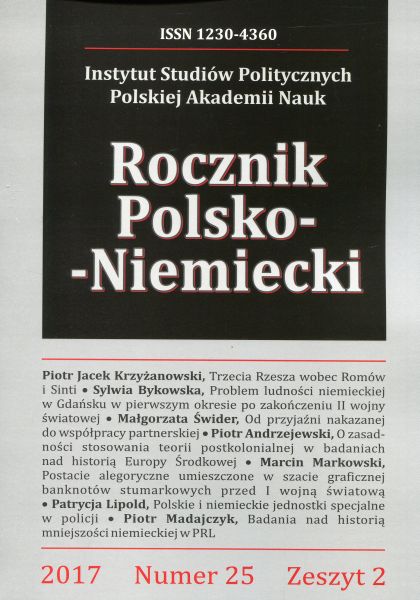Postacie alegoryczne umieszczone w szacie graficznej banknotów stumarkowych emitowanych przez banki Badenii, Bawarii, Saksonii i Wirtembergii przed I wojną światową
Allegorical Figures in the Graphic Design of Banknotes Issued by the Banks of Baden, Bavaria, Saxony and Württemberg Prior to World War I
Author(s): Marcin MarkowskiSubject(s): Politics, Economy, Economic history, Political history
Published by: Instytut Studiów Politycznych PAN
Keywords: paper money; banknote; German local money; iconography
Summary/Abstract: After the unification of Germany in 1871, one of the unifying factors was the introduction of the single currency. The issuing bank was Reichsbank, which was based on a Prussian bank. From 1875, it issued coins and banknotes. Except for the central bank, however, the limited right to issue their own money was left to several provincial banks whose numbers were constantly decreasing. In the early twentieth century there were only four central banks of federal states. The banks of Baden, Bavaria, Saxony and Wurttemberg issued their own paper money until 1935 when they were deprived of their right to do so. Each of these institutions issued 100 Deutsche Mark banknotes whose graphic design differed from the appearance of Reichsbank’s paper money. Banknotes printed for these banks had a rich graphic design. It was not limited to simple ornamentation and symbols, but contained rich decoration in the form of allegorical figures ‘armed’ with the symbols of trade, crafts, agriculture and industry. Some of these characters and their attributes can be identified with specific Greek and Roman gods such as Hermes or Tyche. Among the figures appearing in the graphic design of the banknotes were women with wreaths of oak leaves on their heads, which may be interpreted as personifications of the states. Two busts have been identified as the symbolic rivers of Rhine and Neckar. The presence of allegorical characters is part of the global tendency during the nineteenth and twentieth centuries. At that time, images of deities and symbolic figures referring to the economy were commonly placed on banknotes in European countries and their overseas colonies.
Journal: Rocznik Polsko-Niemiecki / Deutsch-Polnisches Jahrbuch
- Issue Year: 2/2017
- Issue No: 25
- Page Range: 87-105
- Page Count: 19
- Language: Polish

